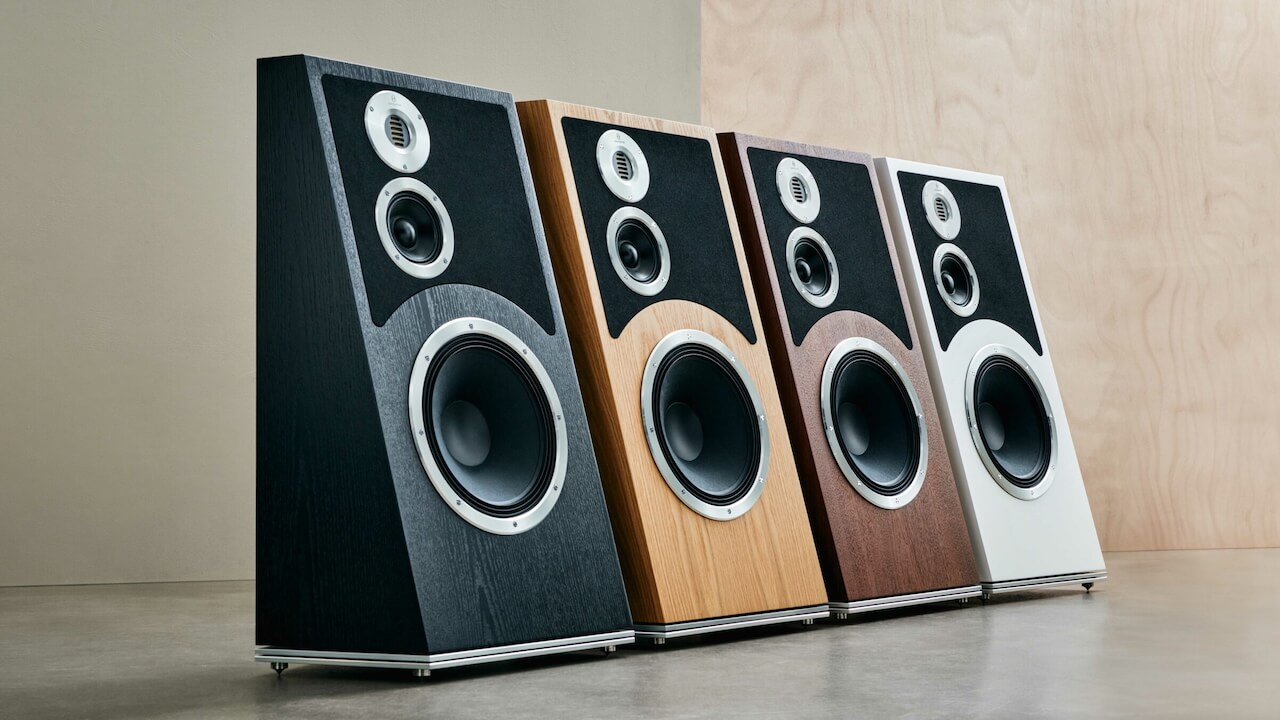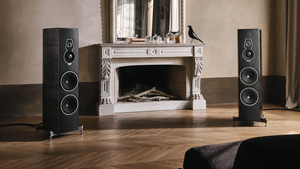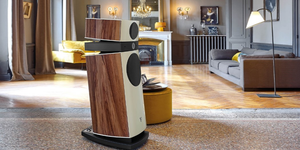
An In-Depth Review of the Audiovector Trapeze Ri
Introduction: The Echo of the Past, The Voice of Now
In the world of high-fidelity audio, the concept of "heritage" is a powerful, yet perilous, currency. It can evoke a golden age of engineering, a lineage of sonic excellence, or it can serve as a gilded cage, trapping a brand in nostalgic reverence at the expense of genuine innovation. The challenge, then, for any manufacturer revisiting a classic design, is to strike a delicate balance: to honor the spirit of the original while imbuing it with a performance that is not merely relevant, but truly state-of-the-art. This is the tightrope walked by Audiovector with its Trapeze Reimagined, or Ri. This is not a simple reissue; it is, as its name proclaims, a philosophical and technological "Reimagination" of a loudspeaker that first broke ground 45 years ago. The central question this review must answer is profound: Can a design born in 1979, a time of vastly different acoustic priorities and engineering capabilities, be fundamentally re-engineered to compete at the highest echelons of the fiercely contested modern market?
To understand the Trapeze Ri is to understand its creator. In 1979, Ole Klifoth founded Audiovector in Denmark with a singular, ambitious vision: to create the "perfect loudspeaker". His approach was one of synthesis—to combine the most desirable attributes of the era's finest designs while systematically engineering out their inherent flaws. The original Trapez, a manageable three-way floorstander that followed a colossal eight-driver prototype, was the first commercially successful embodiment of this vision, establishing core brand principles like linear dynamics and phase coherence that endure to this day.
Today, the Trapeze Ri emerges as a bold, almost defiant statement against the prevailing aesthetic of the high-end loudspeaker: the slim, narrow-baffle tower. Its form is a deliberate return to the wide-baffle principles of its ancestor, yet its internals are armed with 45 years of accumulated knowledge in driver technology, materials science, and acoustic engineering. The very existence of this loudspeaker suggests a market-driven counter-narrative. It implies a growing sentiment among discerning audiophiles that the industry's relentless pursuit of "svelte tower speakers" has, in some cases, led to sonic compromises—particularly in the realms of bass authority, dynamic scale, and the sheer visceral energy of live music. The performance of the Trapeze Ri is consistently described in terms of "power," "authority," and the ability to "play loud without stress," qualities often associated with the fundamental physics of larger drivers and cabinet volumes. Some enthusiasts explicitly feel that "the move to more svelte tower speakers loses as much as it gains". The Trapeze Ri, therefore, is not merely a nostalgic act. It is Audiovector's calculated answer to a perceived void in the market, a strategic product that leverages a classic form factor to deliver sonic benefits that its creators believe have been marginalized by modern design trends. This review will explore whether this "reimagining" succeeds not just as a tribute, but as a world-class transducer in its own right, capable of moving the heart as profoundly as it moves the air.

I. Form Follows Function: The Architectural Philosophy
The visual identity of the Trapeze Ri is inseparable from its acoustic purpose. Its unconventional architecture is not a matter of stylistic whim but a masterclass in functional design, where every angle and surface serves a specific sonic goal.
The Geometry of Sound
At the heart of the Trapeze Ri's design is its iconic trapezoidal cabinet. What Audiovector calls a "lopsided cabinet" is, in fact, a foundational acoustic principle brought to life. A conventional rectangular enclosure is, by its very nature, a resonant chamber, uniquely suited to promoting internal standing waves that can color the sound and introduce distortion. The Trapeze Ri's non-parallel internal surfaces are engineered to decisively eliminate this problem, creating a cabinet that is effectively a "standing wave-free zone". This is the physical manifestation of Audiovector's "No Standing Waves (NSW)" concept, a principle pioneered by the original Trapez.
The cabinet's geometry gives rise to another crucial feature: the raked, or back-leaning, front baffle. This angle serves a dual purpose with elegant efficiency. First, it physically aligns the acoustic centers of the 12-inch woofer, 5-inch midrange, and AMT tweeter, ensuring that the sound from each driver reaches the listener at the same instant. This time-corrected alignment is critical for achieving the phase coherence that has been a cornerstone of Audiovector's philosophy since its inception. Second, the angled baffle creates a "natural toe-in," aiming the drivers directly at the listening position when the speakers are placed parallel to the rear wall. This seemingly simple feature significantly simplifies room placement, making the speakers less fussy and more adaptable to real-world living spaces.
The wide baffle, a necessary consequence of housing a 12-inch woofer, presents its own acoustic challenge: diffraction. Sound waves propagating from the drivers can reflect off the sharp cabinet edges, causing secondary emissions that smear the stereo image and compromise clarity. Audiovector addresses this proactively with its Diffraction Control Concept (DCC). A thick pad of natural felt is meticulously applied to the area surrounding the midrange and tweeter. This absorbent material tames those early reflections, allowing the drivers to behave more like an ideal point source and contributing to a focused, natural, and holographic soundstage. This interconnected design philosophy is a hallmark of sophisticated engineering. The solution to one acoustic challenge (standing waves via the trapezoid shape) becomes the foundation for another advantage (time alignment via the raked baffle), which in turn creates a practical benefit for the user (simplified placement). It is a system where form and function are not just related, but entirely codependent.

Scandinavian Craftsmanship and Domestic Integration
The execution of this complex geometry is a testament to Danish craftsmanship. The cabinets are constructed from high-density fibreboard (HDF), a material chosen for its rigidity and acoustic inertness, and are fortified with considerable internal bracing—a technique Ole Klifoth has found produces better results than simply using thicker panels. The exterior is finished to a luxury standard, with seamless, hand-fitted real wood veneers available in Nordic Oak, Italian Walnut, Black Ash, and White Silk. For those seeking perfect aesthetic harmony, a wide range of custom-painted finishes is also available on request.
The speaker's physical proportions are unusual in today's market. At 87.5 cm tall, 43.5 cm wide, and 42 cm deep, they are decidedly squat and broad compared to the tall, slender towers that dominate the high-end landscape. Yet, several observers have noted a counterintuitive effect: this shape can feel less obtrusive in a domestic setting than its more conventional competition. Rather than piercing the vertical space of a room, the Trapeze Ri occupies a lower, more grounded profile, presenting an aesthetic that is perhaps closer to a piece of fine, mid-century furniture than a piece of imposing audio equipment. It is a testament to this unique appeal that one reviewer noted his "very picky decorator wife fell in love at first site" and preferred the look with the grilles removed. This is a speaker designed not just for the listening room, but for the living room.

II. The Engineering Heartbeat: A Symphony of Custom Drivers & Crossover
Beneath the Trapeze Ri's artful exterior lies a formidable array of bespoke technology. The entire electro-acoustic system is a testament to a holistic design philosophy, where the selection of one component creates a cascade of engineering requirements for every other part of the chain, all in service of a singular sonic goal: coherent, dynamic, and emotionally immediate musical reproduction.
The Isobaric Foundation: Power and Finesse
The low-frequency performance of the Trapeze Ri is built upon an ingenious and complex foundation known as an Isobaric Compound Bass system. A large, forward-facing 12-inch woofer is acoustically coupled to an internally mounted, rear-facing 8-inch driver, with the two units sharing a sealed chamber. This configuration, first theorized in the 1950s, effectively tricks the front driver into behaving as if it is operating within a cabinet of twice the actual volume. The result is a bass response that extends deeper and with greater authority than would otherwise be possible from an enclosure of this size.
The drivers themselves are custom-designed to Audiovector's exacting specifications. The 12-inch woofer features a lightweight yet stiff long-fiber paper cone, driven by a massive 4-inch, fully vented voice coil for exceptional power handling and heat dissipation. The internal 8-inch driver employs a sophisticated sandwich construction made from carbon fiber. This potent combination is engineered to deliver the best of both worlds: the sheer air-moving capability and foundational weight of a large driver, coupled with the speed, control, and articulation of a smaller one. The design's stated goal is to produce bass that is not only deep and powerful but also agile, textured, and free of the resonant "boom or bloom" that can plague lesser designs.

A Coherent Voice: Midrange and Treble Integration
The entire driver and crossover architecture appears to be governed by a single, overarching mandate: speed. The choice of a "blisteringly fast" Air Motion Transformer (AMT) tweeter at the top end necessitates a midrange driver capable of matching its transient response to avoid a sonic disconnect. To this end, Audiovector has developed a proprietary 5-inch midrange driver engine. Its cone is crafted from a lightweight, impregnated paper, but the true innovation lies in its suspension. In place of a traditional rubber half-roll surround, it employs a corrugated "concertina" design. This specialized surround is explicitly engineered for speed and improved dynamics, allowing the cone to move with greater precision and settle more quickly. This driver is powered by a supremely strong vented Neodymium magnet and housed in a chassis made from a combination of aluminum and magnesium, ensuring both magnetic force and structural rigidity.
Crowning the assembly is Audiovector's signature SEC AMT tweeter. Crucially, it is an open-backed design, a feature that stays true to the original concept pioneered by its inventor, Dr. Oskar Heil. Most modern AMT derivatives are sealed, but by leaving the back open, Audiovector eliminates the pneumatic back pressure that can compress the pleated diaphragm's movement. This allows the tweeter to "breathe" more freely, resulting in a more natural, effortless, and extended high-frequency response that reaches an impressive 53 kHz. The unit is mounted via a three-point installation system to decouple it from the cabinet, and its front fascia is precision-milled from a solid piece of aircraft-grade aluminum.

The Unseen Conductor: The Crossover Philosophy
Stitching these high-speed drivers together is a crossover network that embodies the principle of "Occam's razor"—that the simplest solution is often the best one. Audiovector has long championed a gentle, first-order crossover slope of 6 decibels per octave (
For such a simple circuit to work effectively, the quality of its components must be beyond reproach. Audiovector employs custom capacitors that combine polypropylene dielectrics with a tin-flashed copper foil. These components are then subjected to a double cryogenic treatment—freezing them down to °C—a process claimed to realign the copper's molecular structure to reduce resistance. Finally, they are hand-matched to a variance of less than
, a far stricter tolerance than their official
rating. This fanatical attention to detail is not an optional luxury; it is a necessity to realize the full potential of the speaker's ambitious design.
The Art of Synergy: Grounding and Damping Control
Two unique features further enhance the Trapeze Ri's performance and adaptability. The first is the Freedom Grounding Concept, a technology designed to combat movement-induced electrical noise generated within the driver chassis. A dedicated terminal on the rear panel allows an optional, specialized cable to connect the speaker's grounding circuit to an earth ground, such as a wall socket or grounded power distributor. This provides a path for distortion and induced currents to be drained away from the sensitive driver assemblies. The audible effect is described as a lower noise floor, a "blacker background" from which the music emerges, and subtle but noticeable increases in clarity, refinement, and dynamic expression.
The second feature is the Damping Factor Adjustment (DFA), a three-position rotary switch that allows the user to tailor the speaker's electrical characteristics to the connected amplifier. This switch adjusts for the amplifier's damping factor—its ability to control the woofer's movement. Position 1 is for standard solid-state amplifiers, Position 2 is for high-power, high-damping-factor solid-state "behemoths," and Position 3 is for tube amplifiers, which typically have a very low damping factor. This feature demonstrates a deep understanding of system synergy, allowing for optimized performance across a vast spectrum of partnering electronics and making the speaker unusually versatile.
This versatility, however, comes with a caveat regarding power. There is a significant discrepancy in the reported sensitivity figures. Audiovector's official specification, listed consistently across its materials, is a moderately efficient 88 dB. However, one European publication's independent lab measurements recorded a much lower figure of 82.4 dB, a rating they classified as "Low, requires powerful amplifiers". A difference of nearly 6 dB is substantial, representing more than a tripling of the amplifier power required to achieve the same sound pressure level. While measurement techniques can vary, this large a gap suggests that to unlock the speaker's full dynamic potential and its lauded ability to "play loud without stress," a robust, high-current amplifier is likely advisable, regardless of its topology. The Trapeze Ri may be electrically easy to drive, but it appears to be a design that truly thrives on generous reserves of power.
| Feature | Specification |
| Design | 3-Way Floorstanding Loudspeaker |
| Bass Loading | Isobaric Compound System (12” forward-facing, 8” internal) |
| Drivers | 1 x Audiovector SEC AMT Tweeter, 1 x 5” Paper Cone Midrange, 1 x 12” Paper Cone Woofer, 1 x 8” Carbon Fiber Internal Woofer |
| Frequency Response | |
| Crossover Frequencies | |
| Nominal Impedance | |
| Minimum Impedance | |
| Sensitivity | |
| Power Handling | |
| Dimensions (H x W x D) | |
| Finishes | Nordic Oak, Italian Walnut, Black Ash, White Silk (Custom colours on request) |
| Features | Freedom Grounding Terminal, 3-Position Damping Factor Adjustment |

III. The Audition: An Encounter with Musical Energy
Moving from technical schematics to the listening room, the Audiovector Trapeze Ri reveals a sonic character that is as bold and distinctive as its physical form. This is a loudspeaker that does not whisper its intentions; it announces them with confidence, energy, and an infectious sense of musical joy.
Setup and First Impressions: An Unmistakable Character
One of the first pleasant surprises is the speaker's relative lack of fussiness regarding placement. Thanks to the built-in toe-in of its raked baffle, achieving a solid central image is remarkably straightforward. While they, like any high-performance loudspeaker, appreciate some space to breathe—with Audiovector recommending a starting point of around 70 cm from the rear wall—they seem more tolerant of being placed a little closer if domestic constraints demand it.
From the very first notes, the Trapeze Ri's core personality is clear. The sound is described as "exciting" from the outset, "direct and full of energy," with a character that is "fun, even-handed, and punchy". This is not a loudspeaker that prioritizes sterile, analytical neutrality above all else; its primary mission is entertainment and emotional engagement. It possesses a "touch of beauty" for more delicate passages but is always ready to "handle energy" when the music calls for it. One reviewer aptly captured this duality, noting that the Ri combines the "refinement of the brand's R series designs with some added devilment and cheekiness". It is a sophisticated performer that clearly likes to let its hair down.
The Realm of Low Frequencies: Power with Poise
The promise of the complex Isobaric Compound Bass system is delivered in spectacular fashion. When presented with tracks containing deep, powerful bass, such as Massive Attack’s iconic "Angel," the Trapeze Ri responds with a visceral sense of authority. The low frequencies are rendered with immense "power," "punch," and "heft," creating a foundational weight that is felt as much as it is heard. On high-energy electronic music like Ghostrider's "Make Us Stronger," the bass notes land with a "generous chest-thumping power" that can fill a room and energize the listener.
Yet, this sheer force is never brutish or uncontrolled. The most impressive aspect of the Ri's bass is the marriage of this power with exceptional agility, grip, and speed. The isobaric system allows the speaker to dig impressively deep while maintaining a "deeply pleasing level of grip and agility". The bass remains articulate and richly textured, avoiding the slowness or resonant overhang that can plague large, less sophisticated woofers. It is a performance that delivers both the sledgehammer impact of a rock concert and the nuanced plucks of an acoustic bass with equal conviction.
The Soul of the Performance: Midrange and Vocals
The transition from the powerful bass to the midrange is seamless. The midrange driver, with its fast concertina surround, proves to be a superb performer, particularly with the human voice. Vocals are rendered with a natural, dynamic, and deeply communicative quality. The combination of the low-distortion bass system and the agile midrange allows voices to emerge with a "solid foundation," conveying mood and emotion with precision. The presentation is described as "tactile and human," capturing the subtle breaths and inflections that bring a performance to life. This superb cohesion across the critical bass and midrange frequencies creates a unified sonic fabric, presenting instruments and voices as an integrated, believable whole.
Air, Speed, and Delicacy: The AMT in Action
The open-backed AMT tweeter integrates flawlessly with the midrange, contributing to the speaker's overall sense of speed and clarity. The high-frequency performance is consistently described as detailed, refined, and extended, yet entirely free from the hardness, edginess, or "peaky" sound that can induce listening fatigue. It delivers "ample refinement and composure," providing the sparkle and air that allow cymbals to shimmer realistically and strings to float delicately in space. This treble performance is a key contributor to the speaker's ability to organize complex musical information in a way that is always "cohesive and musical" rather than merely analytical.
This forgiving yet thrilling character positions the Trapeze Ri as a kind of "anti-fussy" audiophile speaker. Many high-end designs are so ruthlessly revealing that they can be unforgiving of anything less than a perfect recording. The Trapeze Ri, by contrast, seems engineered to find the joy in everything. It is lauded for its ability to handle everything from "eighties pop, techno classics, slabs of indie rock and heavy metal" without ever becoming harsh. One reviewer stated it most directly: it is "the opposite of the stuffy audiophile loudspeaker that only springs to life when fed beautifully recorded music," a speaker with which one can happily play "musical horror" and simply "enjoy" it. This suggests a transducer designed for the passionate music lover whose primary goal is to revel in their entire collection, not just a handful of pristine "demo tracks."

The Soundfield Rendered: Cohesion Over Expanse
The presentation of the stereo image is a point of nuance and a clear differentiator for the Trapeze Ri. The soundstage is consistently described as well-focused, stable, and delivering a solid, cohesive image between the two channels. However, there is also a consensus that the soundstage is not as expansive, deep, or "out-of-the-box" as that produced by some of the best smaller, narrow-baffle competitors. The sense of holographic, layered depth, in particular, may be less pronounced.
This should not be seen as a flaw, but rather as a characteristic trade-off inherent in wide-baffle designs. What might be conceded in ultimate holographic depth is gained in tonal authority, dynamic scale, and a powerful, direct sense of presence. The sound is less of a miniature diorama constructed behind the plane of the speakers and more of a tangible, room-filling performance projected towards the listener with energy and conviction. Audiovector's "Soundstage Enhancement Concept" literature suggests the sound is designed to fill the room effectively, and reports confirm that the performance remains coherent and engaging even when listening from off-axis positions.
IV. The Final Analysis: A Verdict on the Reimagination
After a thorough examination of its design, technology, and performance, the Audiovector Trapeze Ri emerges not merely as a successful product, but as a compelling argument. It is a loudspeaker with a distinct and charismatic personality, a thoroughly modern performer that masterfully leverages a classic form factor to deliver a sound that is powerful, dynamic, cohesive, and, above all, deeply and joyfully musical.
| Strengths | Weaknesses / Considerations |
| Exceptional Dynamics and Punch: A muscular, authoritative presentation that excels at reproducing musical scale and visceral impact. | Soundstage Not Overly Expansive: Stereo imaging is well-focused but may lack the holographic depth and width of the best narrow-baffle competitors. |
| Powerful, Agile Bass: Deep, chest-thumping, and controlled low-frequency performance without boom, overhang, or lack of texture. | Divisive Aesthetics: The retro, wide-baffle design is a bold statement that may not appeal to those who prefer the elegant, slim profile of modern tower speakers. |
| Seamless Cohesion: Superb integration between the custom drivers, creating a unified and musically coherent sound from top to bottom. | Potential Power Demands: Contradictory sensitivity figures suggest it may require more substantial amplification than official specs imply to perform at its best. |
| Engaging and Musical Character: A fun, energetic, and non-fatiguing sound that brings all genres of music to life, from delicate jazz to high-energy rock. | Cost of Optional Grounding: The Freedom Grounding cable, required to access a key performance-enhancing feature, is an expensive additional purchase. |
| High System Synergy: The Damping Factor Adjustment and benign impedance load make it compatible with a wide range of amplifier topologies. | |
| Flexible Placement: Relatively unfussy about positioning in a room thanks to its built-in toe-in and acoustic design. |
The Trapeze Ri is an unqualified success, but it is not a loudspeaker for everyone. It is not a tool for the forensic analysis of recordings, nor is it designed for the listener who prizes pinpoint imaging and holographic depth above all other sonic virtues. Instead, it is an instrument for profound musical enjoyment.

The Ideal Listener
The ideal owner of the Audiovector Trapeze Ri is an audiophile who values rhythmic drive, dynamic scale, and emotional connection above all else. This is a listener who wants to feel the physical impact of a kick drum, the resonant body of a cello, and the propulsive energy of a full orchestra or rock band. They are more interested in being transported by the visceral thrill of a live performance than in dissecting a recording's spatial cues. They own a diverse and eclectic music collection and want a loudspeaker that makes all of it—from pristine audiophile pressings to compressed 80s pop—sound glorious and engaging. Finally, they appreciate bold, functionalist design and the sophisticated engineering philosophy that underpins it.
Concluding Thoughts
The Audiovector Trapeze Ri is far more than a successful product; it is a triumphant validation of a design philosophy. It argues, with compelling sonic evidence, that some of the wisdom of the past, when re-examined through the uncompromising lens of modern technology, can offer a path to musical truth that is every bit as valid—and in some ways, more exhilarating—than the prevailing design orthodoxies of today. It is a speaker that places the sheer, unadulterated fun of listening to music back at the center of the high-end experience. This is a triumphant reimagination that honors its formidable legacy by courageously refusing to be constrained by it.







Comments